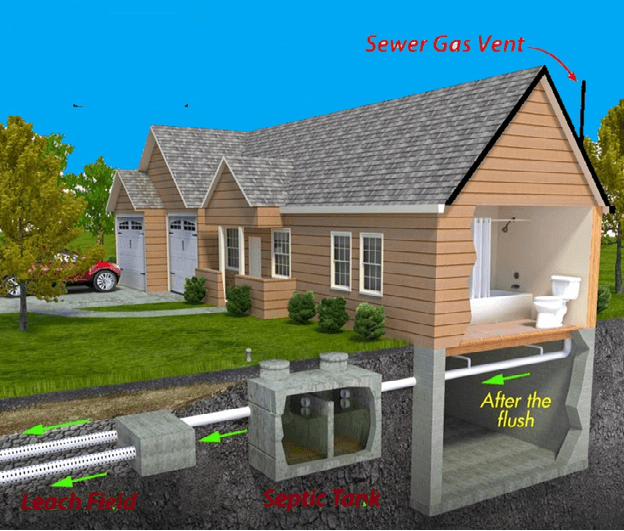
A Septic tank is a submarine sedimentation basin used to treat wastewater through biological decay and drainage processes.
Septic tanks use organic methods and complex technologies to treat wastewater from house bathroom pipes, kitchen leaks, and washing rooms.
The septic tank structure system is comparatively basic. It is a sealed belowground storage tank (mainly rectangular or circular) constructed of fiberglass, plastic, or solid.
Common T-shaped compartments and outlets in septic tanks prevent sludge and slag from leaving the septic tank and entering the drainage area. The septic tanks most widely used in aerobic septic systems.
The septic tank system is a simple on-site wastewater treatment plant (OSSF) that does only fundamental cleaning.
In houses with poor drainage or without a connection to the septic tank of the main sewer system, wastewater can be treated safely.
They collect feces and sewage in a large underground storage tank, which is mainly used in rural areas.
Septic tanks are generally established 50 meters underground by residents. It generally consists of two departments or rooms and a water container in which wastewater collected from the intake pipe.
For people who live in cities and towns, septic tanks are unnecessary because the sewage is discharged directly into the sewage system for clarification. This local water organization will support and manage this. Also, read about.
How Does a Septic Tank Work?
The septic tank will digest organic matter and separate floating substances (such as oil and grease) and solids from the wastewater.
The two pipes connect to the septic tank (inlet and outlet).
The sewage from the house is drawn by an inlet hose and collect in the septic tank. It is kept here sufficient period to disparate solid and liquid waste from each other.
The second pipe is the outlet pipe. The previously cleaned wastewater from the septic tank disparate by this pipe and distributes evenly in the soil and in the water.
After a while, when the sewage was collected, it started to divide into 3 layers.
The top layer consists of oil and fat and floats on all sediments.
The center layer restrains waste pieces and sewage.
The third and lower films consist of pieces that are larger than water and form a film of sludge.
Bacteria in the water tank are best at breaking down the solid waste and then separating the liquid from to drain.
As part of general maintenance, everything that remains on the bottom of the tank should be removed regularly. Because of this septic tanks are just a simple form of wastewater treatment.
Specifically, this is how a typical conventional septic system works:
All the water leaves your home and flows into the septic tank through the main drain.
The septic tank is a closed tank submerged in the earth and is generally made of concrete, fiberglass. Their function is to keep the wastewater large period for the solids to resolve to the bottom and form sludge, while oil and fat float to the top as slag.
A T-shaped water outlet and tray prevent mud and foam from leaving the tank and entering the drain area.
From the water tank, liquid wastewater leaves and penetrates the drain area.
The drainage field is the exhumation of flat, covered, and unsaturated soil. The already treated wastewater is transformed through pipes to the porous surface so that the wastewater can drip into the earth. When sewage enters the soil, the soil absorbs the sewage, processes and distributes it, and eventually discharges it into the groundwater.
If there is too much liquid in the drain area, it overflows, causing the sewage to rise to the surface or back into the toilet and sink.
Eventually, wastewater enters the soil to naturally remove harmful coliforms, viruses, and nutrients. In the intestines of humans or other warm-blooded animals mostly exist a type of bacteria is coliform. It is a signal of human fecal contamination.
How to find your septic system
Once you’ve resolved that you have a septic tank, here are some tips to find it:
- See the “as-built” drawings of your home.
- Inspect that your garden has covered.
- Touch your septic tank service supplier for support.
Failure symptoms of Septic Tanks
Odor is not always the first sign of a septic tank failure. If you experience any of the following issues, contact a septic tank professional:
- The wastewater goes back to the house’s sewer system.
- Collect water in the basement.
- There is an intense smell on every side of the septic tank and drain.
Advantages and Disadvantages of Septic Tank
- Septic systems are environmentally friendly
- They are easy to use
- They require low maintenance
- They are a little bit cheaper
Disadvantages of septic systems
- Septic tank has a high installation cost
- A septic tank needs high cost for pumping